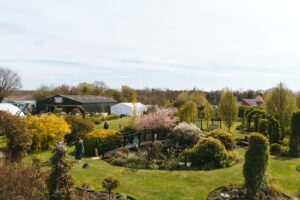Urban deprivation and the built environment
 In the second in a series of essays on Poverty in the UK, commissioned by the Joseph Rowntree Foundation and Prospect magazine, Maria Adebowale argues for the power of placemaking in tackling poverty
In the second in a series of essays on Poverty in the UK, commissioned by the Joseph Rowntree Foundation and Prospect magazine, Maria Adebowale argues for the power of placemaking in tackling poverty
Understanding and tackling the roots of poverty is a challenge and requires unlocking material resources and allowing people to take part in social, economic and environmental decision-making.
Overcoming poverty requires getting to grips with the role that urban places and spaces play both as material resources and as critical social, economic and environmental assets. Social policy and research has, under different party political platforms and grassroots movements, sought to ameliorate urban poverty and remedy injustice by using spaces and places to increase employment, improve public health, tackle pollution and reduce civil unrest.
We are often reminded today that, for the first time in history, there are more people living in urban areas than not. We therefore need to understand the power of urban placemaking in improving jobs, enhancing wellbeing, and bringing culture and education to a changing and diverse population of city-dwellers.
The city we live in, what it looks like, how it is looked after, and the opportunities it provides have an impact on our ability to take part in society. For many, local place and spaces are a daily and visible reminder of economic power and the value placed by society on us as individuals, as neighbours, as members of families and communities.
Creating places that people want to live in is not just a matter of aesthetics and design. Patterns of urban degradation, of both the built and natural environment, are linked globally to multiple forms of deprivation. There is a growing body of evidence to support the claim that place-shaping is central to the process of tackling the roots of poverty and supporting resilient communities. It can act as a collective community asset to alleviate poverty, a source of investment and as a focus for participation and community-driven interventions that transform neighbourhoods.
Poor quality and badly looked after green spaces have a disproportionate impact on marginalised, socially and economically excluded communities and groups. The task of placemaking therefore has to be to create opportunities for empowerment and to show how communities can design their way out of poverty. Tentative steps have already been taken towards integrating the placemaking agenda with campaigns for sustainability and environmental justice. Informally shared indicators have aimed to measure how far we have got in relation to access to green spaces, quality of housing stock and decision-making.
In the past, governments’ quality of life and wellbeing strategies have led to policy commitments designed to eradicate poverty through placemaking. There is a historical legacy here: ‘slum clearance’, environmental equality, localism, urban design, urban renewal, asset-transfer and regeneration. Placemaking that aims to reduce the impacts of poverty has, at its heart, a social agenda that seeks to improve the quality of life, specifically that of the most vulnerable, by improving both the natural environment and built infrastructure, and by seeking to go beyond minimum standards.
An effective placemaking strategy requires the adoption and enforcement of regulatory frameworks at national level. As yet, however, there is no integrated approach of the kind that is needed, let alone a strong sense of policy leadership for placemaking in poor urban neighbourhoods.
What is really needed is to find political, social and environmental solutions to the poor physical condition of deprived neighbourhoods. We need to overcome the tendency for placemaking to be purely design-led, and to find an approach that moves from aesthetics to wider social, economic and environmental concerns. A model of this sort would be an essential tool for tackling poverty and improving the built and natural environment. A number of exciting placemaking projects already use this model to focus on innovative and collaborative projects that are concerned both with how a place looks and feels and with the empowerment of communities to take up ownership of projects that provide the opportunity for living spaces and places which can enhance identity and self-reliance.
Nevertheless, neighbourhoods with shrinking green space and poor built infrastructure are still being robbed of valuable assets, both outdoors and indoors: places to eat, to meet neighbours, grow food, create social enterprises, get training and to celebrate heritage, art and culture. The present economic climate is particularly gloomy for already poor urban neighbourhoods with cuts to local authority services, shops closing down and the selling-off of green spaces. The danger is that poor places create inequalities that become ingrained in the psyche of a neighbourhood and of the people who live there. For many, the only solution is to plan their escape and to take what social and economic capital they have with them.
Of course everyone has the right to choose to move and live where they like. But having to leave your home, friends and family in order to live somewhere with basic infrastructure and services should not be the only answer for people living in poverty. Until we find ways of dealing with these concerns, we will continue to create the tinder for urban breakdown.
In order to use placemaking to tackle poverty, therefore, we need to understand how changing urban conditions create and exacerbate deprivation, and then to establish how community-led solutions can be devised.
- This essay is one of a collection including contributions from AC Grayling, Leanne Wood, Roger Scruton and Rowan Williams, published in partnership between the JRF and Prospect Magazine. To read other essays or download the full report, please click here















